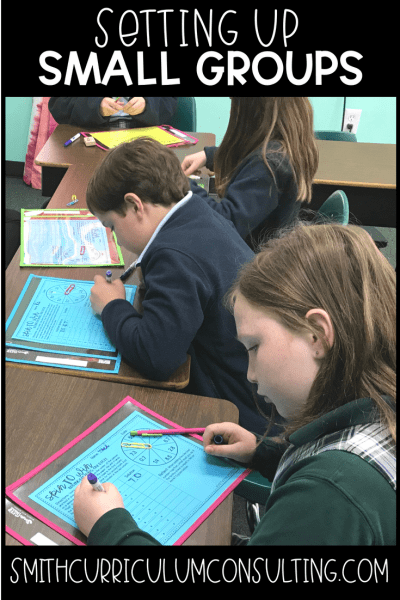 Setting up your small groups for math workshop involves a little bit of work. While there is no right or wrong way to group your students for small groups (also known as Guided Math), below is what I have done based on research and personal use in my classroom over the course of several years of trial and error.
Setting up your small groups for math workshop involves a little bit of work. While there is no right or wrong way to group your students for small groups (also known as Guided Math), below is what I have done based on research and personal use in my classroom over the course of several years of trial and error.
Steps to Setting up Small Groups for Math Workshop
First, using a screener of your choice, determine what ability level each of your students are on. You can do this by their prior year test scores, a pre-test per strand of objectives, etc. Once you have done this then place your students in a list from the highest scoring to the lowest scoring. This will be your master list for grouping that you will need for the next steps.

The example shows that Alice scored the highest score while Tristan was the lowest scoring.
- Find the middle of your list. This will separate your high from low. You may have to adjust it based on students who scored similar grades so there may be more students in one of the halves than the other.
- Second, find the half-way point on each of your halves. Label each of these if needed to help in assist you in pairing students.
- Decide how many students you are wanting in each of your small groups (4-6 is a good standard). Based on this start pairing your groups up according to the following.
For a group of 20 students (like our example) I would typically stick with 4 separate groups.
Starting with my Highest student, I would them match them with the first High Low student. Then I would go back and match add the second highest student, the highest mid-high and the lowest mid-high student.
After making a diversified high group, I would move on to my low groups. For the last group I would put my lowest three students and then my lowest two of the high-low group.
My final group of students is a mix of high and mid high and is compromised of the lowest three of the high group and middle two of the mid-high group.
 After putting these four groups together I have a high group, a high/mid-high group, a high-low/mid-low group and a mid-low/low group. This allows for ability level work as you pull small groups to your table.
After putting these four groups together I have a high group, a high/mid-high group, a high-low/mid-low group and a mid-low/low group. This allows for ability level work as you pull small groups to your table.
Things to Remember
One thing that you need to remember when setting up your Guided Math Groups, these can change at any time based on the concepts that you are teaching. Also, your Guided Math groups aren’t the same as your Math Workshop Rotation groups. Your Math Workshop groups are mixed-level ability groups so that students will work together to learn from each other easily.
So as you think of your set-up of small groups, think about what type of screener or data that you are going to use to create your grouping. Sit down with your data and your class list and crank it out using the method I talked through above.
Are you ready to dig in and learn all there is to know about Math Workshop in one concise place? Grab my Math Workshop eBook today that includes 42 pages of of all the information you need to get started as well as over 20 EDITABLE templates to keep you organized and on your toes with planning and documentation throughout the year!
Teach Me About Math Workshop!
Looking for all the latest about using Math Workshop in the Middle Grades? Join today and grab the FREE Editable Math Workshop Sheets and all of the great emails to come your way!
Success! Now check your email to confirm your subscription.




